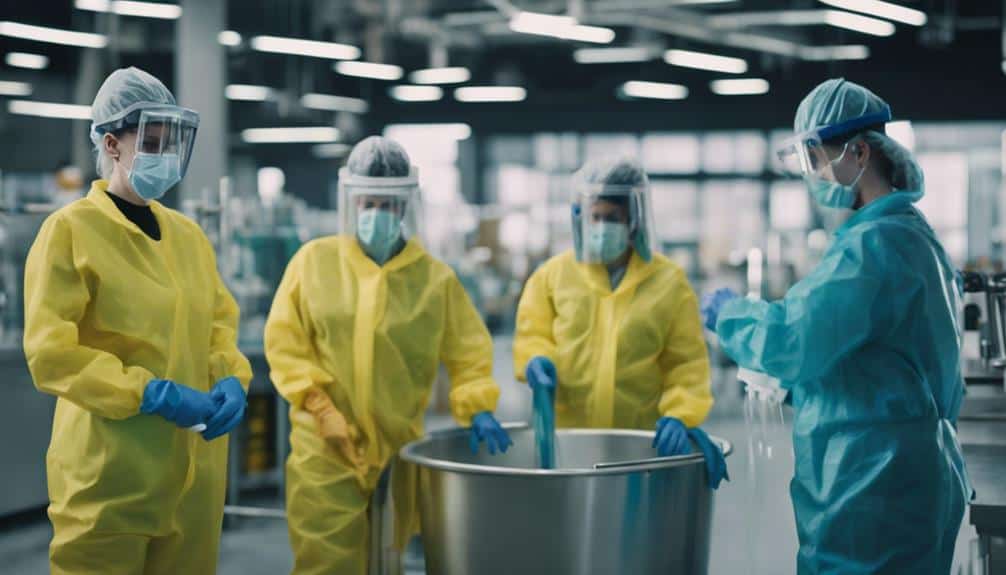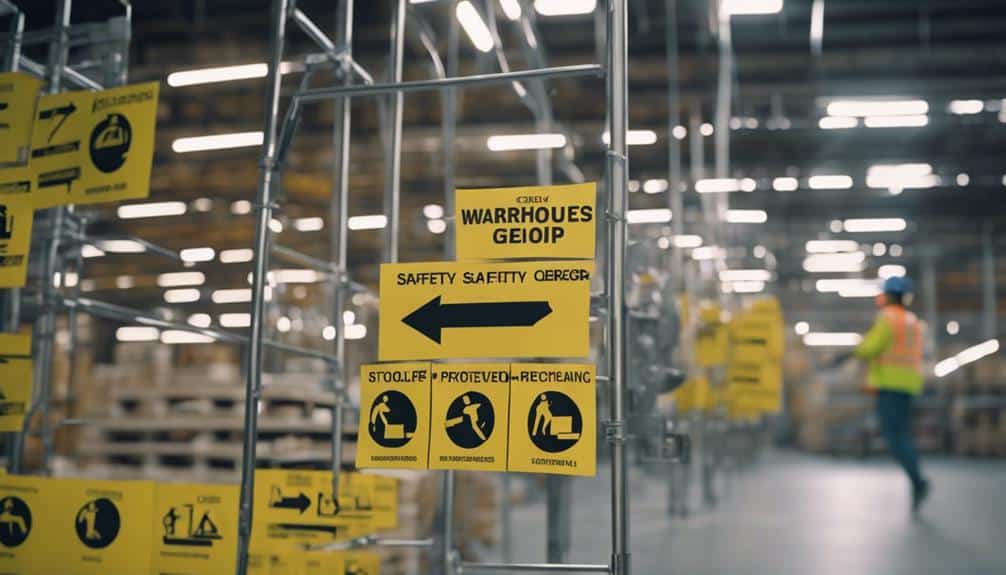Workplace safety is essential, requiring a proactive approach and strict adherence to safety guidelines. Emphasizing the importance of safety fosters a culture of accountability and boosts efficiency.
Regular audits, thorough training, and proper use of protective equipment are indispensable for maintaining a secure work environment. Implementing safety measures not only safeguards employees but also enhances the organization’s reputation. Understanding these critical tips is key to ensuring success in workplace safety.
Key Takeaways
- Emphasize a proactive approach to workplace safety to prevent accidents.
- Provide thorough training on safety procedures for all employees.
- Regularly inspect and ensure proper use of protective equipment.
- Implement and enforce safety protocols to create a secure work environment.
- Conduct safety audits to identify hazards and drive continuous improvement.
Importance of Workplace Safety

Emphasizing the paramount significance of workplace safety underscores a proactive approach towards mitigating potential hazards and fostering a culture of well-being within the organizational setting. Establishing a robust safety culture encourages employees to prioritize reporting hazards promptly, contributing to a safer work environment.
By instilling a proactive reporting system, organizations can swiftly address and rectify unsafe conditions, ensuring the well-being of all staff members. This emphasis on reporting hazards not only prevents accidents and injuries but also promotes a sense of shared responsibility for maintaining a safe workplace.
Encouraging open communication and vigilance regarding potential dangers cultivates a proactive safety culture where employees feel empowered to contribute to the overall safety and security of the work environment.
Benefits of Safety Measures
Instilling a proactive safety culture within an organization not only fosters a sense of shared responsibility for maintaining a safe workplace but also brings forth a multitude of benefits associated with implementing safety measures.
- Improved Efficiency: Safety measures streamline processes, reducing downtime caused by accidents or injuries, ultimately increasing overall productivity.
- Enhanced Employee Well Being: Prioritizing safety boosts morale, reduces stress levels, and creates a conducive environment for employees to thrive.
- Cost Savings: Fewer accidents mean lower workers’ compensation costs and reduced expenses related to injuries, leading to financial benefits for the organization.
- Positive Reputation: Demonstrating a commitment to safety not only attracts high-quality employees but also enhances the company’s image in the industry and community.
Training on Safety Procedures

Training on safety procedures is a fundamental aspect of creating a secure work environment. It is essential for equipping employees with the necessary skills and knowledge to mitigate risks effectively. Interactive simulations and hands-on workshops are valuable tools in providing practical experience and enhancing understanding of safety protocols.
New employees, in particular, benefit from these training methods as they have a higher risk of accidents due to lack of familiarity with workplace hazards. By incorporating interactive simulations and hands-on workshops into safety training programs, organizations can guarantee that employees are well-prepared to operate equipment safely and respond effectively in emergency situations.
This proactive approach to training fosters a safety-conscious culture within the workplace, ultimately reducing the likelihood of accidents and injuries.
Use of Protective Equipment
Guaranteeing the appropriate utilization of protective equipment is crucial in upholding a safe and secure work environment for all employees. When it comes to the use of protective equipment, several critical factors must be considered to ensure compliance and safety gear selection:
- Regular Inspections: Conduct routine checks to verify the protective equipment is in good condition.
- Proper Fit: Ensure that all employees have access to correctly fitting protective gear to maximize safety.
- Training Programs: Implement training sessions on the accurate usage of safety equipment to enhance effectiveness.
- Feedback Mechanisms: Establish channels for employees to provide feedback on the comfort and functionality of the protective gear.
Implementation of Safety Protocols

The proper implementation of safety protocols is paramount in fostering a secure work environment and minimizing the risk of accidents and injuries among employees. Establishing a strong safety culture within the organization is essential to guarantee that safety protocols are followed diligently.
Employees must be trained on emergency preparedness procedures to respond effectively in case of any unforeseen events. Regular drills and training sessions can enhance employees’ readiness during emergencies. Additionally, having detailed safety protocols in place, such as specific procedures for safe job performance and guidelines for emergency situations, contributes greatly to accident prevention.
Conducting Safety Audits
By meticulously examining workplace environments and procedures, safety audits play a pivotal role in identifying potential hazards and ensuring the effectiveness of safety programs.
- Enhancing Safety Culture: Safety audits foster a culture of safety within the organization, encouraging employees to prioritize safety in their daily tasks.
- Proactive Hazard Identification: Through safety audits, hazards are identified in advance, allowing for timely corrective actions to prevent accidents.
- Continuous Improvement: Safety audits contribute to the ongoing improvement of safety measures, ensuring that the workplace remains safe and secure.
- Employee Engagement: Involving employees in safety audits promotes a sense of ownership and responsibility towards maintaining a safe work environment.
Communication Through Labels and Signs

Effective communication through labels and signs is an essential aspect of promoting workplace safety and mitigating potential hazards. Safety messaging through visual communication plays an important role in alerting employees to dangers and reminding them of necessary precautions.
Categories such as caution signs, prohibition signs, and hazard signs help employees understand the risks associated with different areas or activities in the workplace. It is important that these signs are simple, noticeable, and aligned with safety standards to guarantee clear communication.
Consistency in the information provided on labels and signs is key to reinforcing safety policies and promoting a culture of safety. By utilizing effective safety messaging and visual communication, organizations can create a safer work environment for all employees.
Frequently Asked Questions
How Can Workplace Safety Measures Impact Employee Morale and Job Satisfaction?
Workplace safety measures directly impact employee morale and job satisfaction by fostering a secure environment that promotes trust and engagement. Increased safety leads to higher productivity levels, creating a positive work culture that values employee well-being.
What Are the Legal Implications for Employers Who Fail to Prioritize Workplace Safety?
Neglecting workplace safety exposes employers to legal consequences such as fines, lawsuits, and reputation damage. Employer responsibility mandates prioritizing safety to protect employees from harm, fostering a secure and compliant work environment.
How Can Employees Actively Participate in Maintaining a Safe Work Environment?
Employee engagement is pivotal for safety initiatives. Encourage reporting of hazards, follow safety protocols, and actively participate in safety audits. Training on procedures, utilizing protective equipment, and promoting a safety culture enhance a safe work environment.
What Role Does Management Play in Fostering a Culture of Safety in the Workplace?
Management support is pivotal in fostering a robust safety culture at the workplace. Through proactive leadership, clear communication, and consistent enforcement of safety protocols, management sets the tone for prioritizing safety, ultimately ensuring a secure work environment.
How Do Advancements in Technology Contribute to Improving Workplace Safety Practices?
Advancements in technology enhance workplace safety by enabling enhanced communication through real-time alerts and notifications. Wearable technology like smart helmets and vests monitor key signs, detect hazards, and provide immediate feedback, contributing to proactive safety practices.
Conclusion
In summary, prioritizing workplace safety is essential for organizational success.
By following important safety tips such as implementing safety protocols, conducting audits, and providing training, businesses can create a secure work environment for all stakeholders.
While some may argue that safety measures are time-consuming and costly, the long-term benefits far outweigh the initial investment.
Ultimately, a proactive approach to workplace safety not only protects employees but also enhances productivity and reputation.





